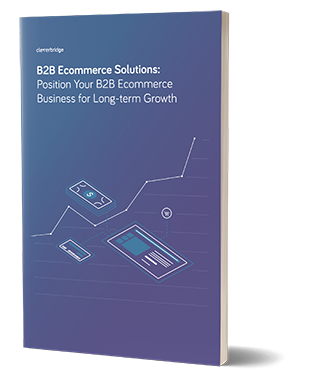The expansion of B2B ecommerce shows no sign of slowing down, with Forrester projecting growth to reach $1.8 trillion in the U.S. by 2023, and account for 17 percent of total U.S. B2B sales overall.
Driven by the demand to find a high-quality product at the right price point, business decision makers often leverage the many resources at their fingertips to ensure they become a satisfied customer – from research and reviews, to price comparisons and discounts.
More and more, B2B customers want to have the ease of use, automation and convenience normally reserved for the B2C market, similar to that of an Amazon, Etsy or Zappos. To that end, B2B companies must forge ahead with a digital-first sales approach to ensure they’re tailoring to their increasingly digital-first customer base.
B2B Buying Behavior
As a B2B company, your product is likely complex, with near endless configurations to fulfill the needs of your customers. To that end, it’s indeed tempting to rely on more traditional marketing and sales processes – and the complexity of your business is likely not a deterrent to holding on to ways of old.
Some 67 percent of B2B buyers say they’d prefer not to interact with a salesperson when researching a product, however, and 70 percent prefer to buy from a website, according to a Forrester report. It’s vital to meet your customers where they are, instead of where you are, if you want to capture their business.
“B2B digital pros must recalibrate their investments to match where their customers are starting their journeys, which is increasingly online,” the report reads.
B2B Online Store Fronts
Buoyed by the popularity B2C ecommerce companies, B2B buyers are more often using self-service platforms for the lower-value, more straight forward purchases. Amazon Business, for example, has skyrocketed in profitability from $1 billion in sales in 2016 to $10 billion in 2018.
It’s vital for B2B companies to offer a similar online experience, or else risk losing prospects and customers to the digital juggernauts. According to Forrester, only 13 percent of respondents to a survey said a typical B2B website was more user-friendly than the likes of Amazon.
Offering a better online experience not only attracts and retains more customers, but it allows your sales team to focus on more higher-value selling that often requires sales support – while the lower-value contracts take care of themselves.
Salespeople as Research Resources
B2B sellers often focus on the value proposition of their offering, and tend to know their product selection inside and out. Although this remains vitally important, more and more B2B buyers want a sales rep to maintain a rich understanding of their business, their competition, challenges and opportunities, and to provide an immediate sense of value.
People who make large purchase decisions for their company have no doubt developed a callous to traditional “marketing” tactics, so view your sales team as not just the liason between prospect and purchase, but rather “outsourced research partners,” as Forrester puts it, who can offer use cases and data points that prove the value of your product’s worth, instead of simply selling it.
One way to do this is have your sales team involved earlier in the sales funnel – awareness instead of simply consideration and decision – via multiple avenues, like email, chat, social media and video. This positions your company as a partner to a potential prospect rather than simply a service provider.
Make a ‘Channel’ Shift

“Today’s B2B buyers move freely between self-service, hybrid, and full-service commerce,” according to the Forrester report. Meaning, the sales funnel is no longer linear, and prospects bounce around the decision-making process based upon their preferred research and buying preferences, business model, and ultimately whether it’s a low- or high-value commitment to their company.
Applying a digital-first approach to your business allows the following key benefits for both kinds of business decisions, according to Forrester.
Digital-first applied to low-consideration purchases:
– Removes cost
– Expands reach
– Drives incremental revenue
– Increases customer satisfaction
Digital-first applied to high-consideration purchase:
– Improves the quality of customer engagement
– Enables field salespeople to earn higher margins
Want more like this? Check out other cleverbridge posts on the B2B buying process:
- Leverage CPQ for a Shorter Sales Cycle, Increased Revenue
- Renewal Automation: Grow Your Digital B2B Business
- Navigating the B2B Sales Role in the Face of Growing Ecommerce
Learn how cleverbridge can help manage, monetize and optimize your digital business as you continue to grow. We take responsiblity for recurring billing, global payment processing, compliance, customer service, and more. Contact our sales team today.
Kyle Shamorian is the content marketer for cleverbridge. Connect with him on LinkedIn.